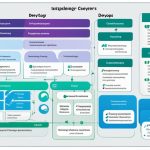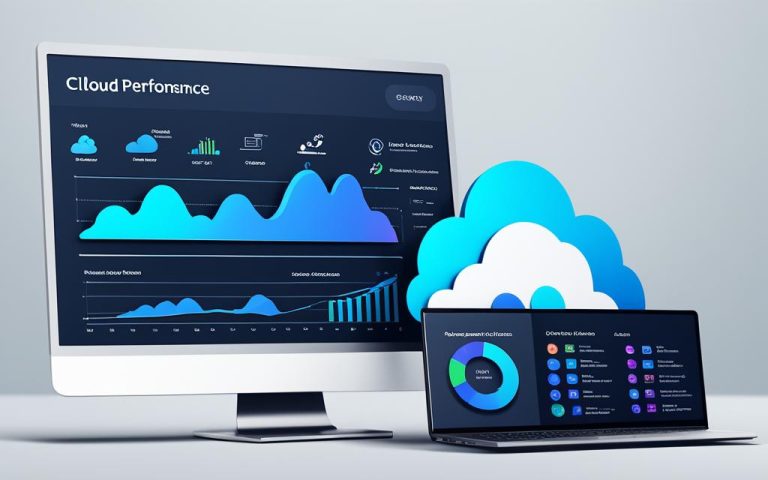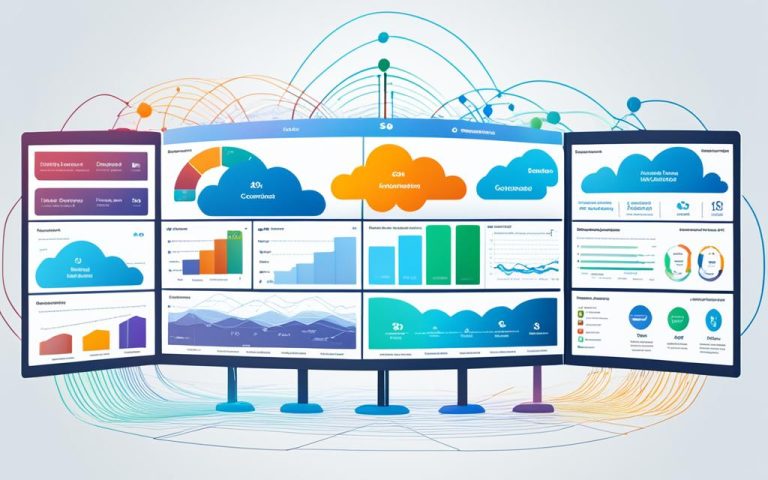Cloud load balancing tools are essential for optimizing network performance and ensuring efficient resource utilization in cloud environments. By distributing network traffic across multiple servers, load balancers help prevent overloading and failures, resulting in improved scalability, reliability, and user experience.
In this article, we will explore various load balancing tools that enable efficient cloud network management. These tools, such as SolarWinds SAM, LoadMaster, NGINX, Zevenet, Incapsula, and Google Cloud’s Cloud Load Balancing, offer a range of features to enhance cloud network efficiency.
SolarWinds Server and Application Monitor (SAM)
SolarWinds Server and Application Monitor (SAM) is a widely-used and comprehensive tool designed to monitor on-premise, cloud, or hybrid application environments. Offering a multitude of features, SAM enables organizations to ensure the optimal performance and availability of their critical applications and systems.
SAM provides a range of templates tailored to various applications and systems, including Windows, Linux, Java, and Office 365. These templates simplify the monitoring process by providing pre-configured settings and thresholds for different applications, allowing organizations to quickly implement effective monitoring strategies.
One of SAM’s standout features is its built-in AppStack dashboard. This intuitive dashboard provides a contextual view of application dependencies within the IT infrastructure. By visualizing the relationships between applications and their corresponding servers, IT teams gain valuable insights into the impact and potential disruptions caused by specific applications.
With SAM’s dynamic maps, organizations can automatically discover the intricate relationships between applications and servers. These visual representations help teams understand the dependencies and connections within their IT ecosystem, facilitating efficient troubleshooting and optimization efforts.
SAM also offers advanced IT data correlation capabilities. By consolidating data from various sources, such as logs, events, and performance metrics, SAM provides a holistic view of the entire application and infrastructure stack. This correlation enables IT teams to identify patterns, trends, and potential root causes of issues, empowering them to make informed decisions and take proactive measures.
For effective reporting and alerting, SAM offers customizable reporting capabilities. Organizations can tailor reports to their specific requirements and generate automated alerts based on predefined thresholds or conditions. This flexibility ensures that IT teams stay informed about the performance and health of their applications and systems, enabling them to address potential issues before they impact end-users.
| Key Features of SolarWinds Server and Application Monitor (SAM) |
|---|
|
LoadMaster
LoadMaster is a powerful load balancing tool designed to enhance network efficiency in private and multi-cloud environments. With its comprehensive features and intuitive interface, LoadMaster ensures security, performance, and seamless application delivery.
Key Features of LoadMaster:
- User-friendly interface for easy configuration and management.
- Centralized management for efficient control of load balancers across the network.
- Application templates that simplify the deployment of popular applications.
- Scalability to meet the demands of growing traffic.
- Integration with third-party tools for enhanced functionality and flexibility.
- Around-the-clock support to address any technical issues.
LoadMaster not only distributes traffic evenly among servers but also monitors and resolves application issues in real-time. Its robust performance ensures optimal application availability, responsiveness, and user experience.
LoadMaster Architecture
LoadMaster architecture is based on a highly reliable and scalable design. It consists of multiple load balancer servers, virtual or physical, working together to handle incoming traffic efficiently. The load balancers are configured based on load balancing algorithms to evenly distribute requests across backend servers. They act as a single entry point for incoming traffic, optimizing resource utilization and providing high availability.
To further illustrate the LoadMaster architecture, here is a table showcasing its key components:
| Component | Description |
|---|---|
| Load Balancer Servers | The servers responsible for load balancing and distributing traffic. |
| Backend Servers | The servers that host the applications or services being load balanced. |
| Virtual Services | The logical representation of an application or service being load balanced. |
| Load Balancing Algorithms | Algorithms used to determine how traffic is distributed across backend servers (e.g., Round Robin, Weighted Round Robin, Least Connections). |
| Health Checks | Periodic checks performed by LoadMaster to ensure the health and availability of backend servers. |
By leveraging its advanced architecture and feature set, LoadMaster streamlines the load balancing process and maximizes the efficiency and performance of cloud-based applications.

NGINX
While initially known as a high-speed web server, NGINX has gained popularity as a load balancing tool. It can manage inbound traffic and distribute it to slow or inactive upstream servers. NGINX offers powerful network administration features, content caching, and session persistence. It is known for its high performance, cost-effectiveness, and ability to handle millions of requests per second. NGINX can be deployed on public and private clouds, virtual machines, and containers.
Key Features of NGINX:
- High-speed web server and load balancer
- Inbound traffic management and distribution
- Powerful network administration features
- Content caching to improve performance
- Session persistence for uninterrupted user experience
- Cost-effective and scalable solution
- Supports millions of requests per second
- Compatible with public and private clouds, virtual machines, and containers
NGINX’s ability to efficiently balance loads and handle massive traffic volumes makes it a top choice for organizations looking to optimize their cloud infrastructure. Whether it’s handling incoming requests or managing resources, NGINX delivers exceptional performance, reliability, and flexibility.
Zevenet
Zevenet is an open-source load balancing solution designed to meet the needs of various industries, including education, healthcare, telecoms, and entertainment. This powerful tool offers a range of features that contribute to improved application delivery control, network optimization, and automation of scalable infrastructure.
One of Zevenet’s standout capabilities is its advanced Intrusion Prevention and Detection System (IPDS), which provides robust protection against Distributed Denial of Service (DDoS) attacks. With Zevenet, organizations can benefit from enhanced security measures that ensure uninterrupted service and protect sensitive data.
Zevenet is highly regarded for its interoperability and ability to integrate with other solutions through an Application Programming Interface (API). This enables seamless collaboration across different platforms and enhances the overall efficiency of load balancing operations.
“Zevenet’s open-source nature makes it an attractive choice for businesses seeking flexible and customizable load balancing solutions. Its extensive range of features, coupled with its ability to integrate with diverse technologies, empowers organizations to optimize their network infrastructure, streamline operations, and deliver exceptional user experiences.”
Incapsula
When it comes to load balancing solutions, Incapsula stands out as a reliable choice. With its advanced capabilities and robust features, it enables organizations to optimize application performance and reduce server load effectively.
Real-Time Server Monitoring and Health Checks
Incapsula offers real-time server monitoring and health checks, ensuring that your servers are always up and running at their best. By constantly monitoring server health, Incapsula can detect and address potential issues before they cause downtime, keeping your applications and processes running smoothly.
Automatic Failover and Real-Time Traffic Monitoring
One of the key strengths of Incapsula is its support for automatic failover between primary and secondary sites. In the event of a server failure, traffic is seamlessly redirected to the backup site, minimizing disruptions and ensuring continuous availability. Additionally, Incapsula provides real-time traffic monitoring, allowing you to analyze and optimize load distribution for optimal responsiveness.
Secure and Speedy Performance
Incapsula prioritizes security without compromising on speed. It employs robust security measures to protect your applications and servers from various threats, including DDoS attacks. Additionally, Incapsula offers features like IPv6 load balancing, source IP-based traffic steering, and WebSockets support, enhancing both security and performance.
“Incapsula is known for its secure and speedy performance, making it an excellent choice for organizations seeking optimized load balancing solutions.”
With its comprehensive range of features and capabilities, Incapsula provides organizations with a reliable load balancing solution that ensures optimal application performance, reduces server load, and enhances overall network efficiency.
Cloud Load Balancing Overview (Google Cloud)
Google Cloud’s Cloud Load Balancing is a powerful solution that optimizes the distribution of network traffic across multiple servers. It utilizes reliable technologies like Maglev, Andromeda, Google Front Ends, and Envoy to ensure efficient load balancing and improve application performance.
With a comprehensive portfolio of application and network load balancers, Google Cloud provides various options to meet specific needs. These include:
- Global Proxy Load Balancers: These load balancers distribute traffic across multiple regions, providing global availability and reducing latency.
- Regional Proxy Load Balancers: Designed for regional deployments, these load balancers optimize traffic within a specific geographic area.
- Passthrough Load Balancers: This type of load balancer directs traffic to backend instances without modifying the packet headers, making it suitable for protocols that require end-to-end transparency.
Cloud Load Balancing offers several features that enhance its functionality:
- Seamless Autoscaling: The load balancers automatically adjust capacity based on traffic demands, ensuring optimal performance and resource utilization.
- Software-Defined Load Balancing: It enables flexible management and configuration of load balancers through APIs and infrastructure-as-code practices.
- Layer 4 and Layer 7 Load Balancing: Cloud Load Balancing supports both transport layer (Layer 4) and application layer (Layer 7) load balancing, allowing organizations to choose the level of traffic routing that best suits their needs.
Furthermore, Google Cloud’s Cloud Load Balancing integrates seamlessly with other services, such as Cloud CDN for content delivery acceleration and Google Cloud Armor for enhanced security.
Conclusion
Load balancing tools are integral to optimizing the performance, availability, and efficiency of cloud applications, websites, and databases. By distributing traffic evenly among servers, these tools prevent resource overload and ensure a seamless user experience. Notable load balancing tools such as SolarWinds Server and Application Monitor (SAM), LoadMaster, NGINX, Zevenet, Incapsula, and Google Cloud’s Cloud Load Balancing offer a wide range of features and capabilities to enhance network efficiency.
SolarWinds SAM provides comprehensive monitoring for on-premise, cloud, and hybrid application environments. With its built-in AppStack dashboard and dynamic maps, administrators gain valuable insights into application dependencies and IT infrastructure. LoadMaster, on the other hand, offers advanced security, scalability, and central management for private and multi-cloud environments. NGINX stands as a high-performance load balancing tool capable of managing large-scale inbound traffic, while Zevenet, an open-source solution, offers application delivery control, optimization, and reliable DDoS attack protection.
Incapsula, a trusted load balancing solution, optimizes application performance, reduces server load, and ensures seamless traffic distribution. Google Cloud’s Cloud Load Balancing, built on reliable technologies, provides a comprehensive portfolio of application and network load balancers. With features like seamless autoscaling and Layer 4 and Layer 7 load balancing, organizations can achieve scalability, reliability, and cost-effectiveness in their cloud environments.
By implementing these cloud load balancing tools, organizations can optimize their resources, improve network efficiency, and enhance the overall performance of their cloud-based applications. Whether it’s monitoring application dependencies, securing infrastructure, or distributing traffic intelligently, these tools are essential for achieving the desired scalability, availability, and cost-effectiveness in a cloud environment.
FAQ
What is load balancing?
Load balancing is the process of dividing network traffic across multiple servers to optimize performance and prevent failures.
How does load balancing work?
Load balancing involves the use of load balancer tools that act as routers to direct traffic to different servers. Load balancing algorithms determine which server should handle incoming requests.
What are load balancing algorithms?
Load balancing algorithms, such as Round Robin, Least Connections, Least Response Time, and Least Bandwidth, help determine which server should handle incoming requests.
Why are load balancers essential?
Load balancers are essential for eliminating downtime, handling peak performance, and eliminating redundancy in multi-server clusters and high availability solutions.
What is SolarWinds SAM?
SolarWinds SAM is a comprehensive tool that allows monitoring of on-premise, cloud, or hybrid application environments. It offers templates for various applications and systems, including Windows, Linux, Java, and Office 365.
What does SolarWinds SAM offer?
SAM’s built-in AppStack dashboard provides a contextual view of application dependencies within the IT infrastructure. Its dynamic maps automatically discover the relationship between applications and servers. SAM also offers IT data correlation and custom reporting and alerting capabilities.
What is LoadMaster?
LoadMaster is a powerful load balancing tool suitable for private and multi-cloud environments. It offers security and performance for cloud applications with a user-friendly interface, centralized management, and application templates.
What are the features of LoadMaster?
LoadMaster can be easily scaled up or down and integrates with third-party tools. It provides around-the-clock support and helps detect and resolve application issues in real-time.
What is NGINX?
NGINX is a load balancing tool initially known as a high-speed web server. It can manage inbound traffic and distribute it to slow or inactive upstream servers.
What are the features of NGINX?
NGINX offers powerful network administration features, content caching, and session persistence. It is known for its high performance, cost-effectiveness, and ability to handle millions of requests per second.
What is Zevenet?
Zevenet is an open-source load balancing solution suitable for various industries, including education, healthcare, telecoms, and entertainment. It offers application delivery control, network optimization, and automation of scalable infrastructure.
What are the features of Zevenet?
Zevenet provides an advanced Intrusion Prevention and Detection System for protection against DDoS attacks. It is known for its interoperability and integrates with other solutions through API.
What is Incapsula?
Incapsula is a reliable load balancing solution that optimizes application performance and reduces server load.
What are the features of Incapsula?
Incapsula offers real-time server monitoring and health checks to prevent downtime. It supports automatic failover between primary and secondary sites and provides real-time traffic monitoring. Incapsula is known for its secure and speedy performance and offers features like IPv6 load balancing, source IP-based traffic steering, and WebSockets support.
What is Cloud Load Balancing (Google Cloud)?
Cloud Load Balancing is a load balancing solution built on reliable technologies like Maglev, Andromeda, Google Front Ends, and Envoy. It offers a comprehensive portfolio of application and network load balancers.
What features does Cloud Load Balancing provide?
Cloud Load Balancing provides features like seamless autoscaling, software-defined load balancing, and support for Layer 4 and Layer 7 load balancing. It integrates with other Google Cloud services like Cloud CDN and Google Cloud Armor for enhanced performance and security.
How do load balancing tools improve network efficiency?
Load balancing tools play a crucial role in optimizing the performance and availability of cloud applications, websites, and databases. They help distribute traffic evenly among servers, prevent overloading of resources, and ensure a seamless user experience.
What are the benefits of implementing load balancing tools?
By implementing load balancing tools like SolarWinds SAM, LoadMaster, NGINX, Zevenet, Incapsula, and Cloud Load Balancing, organizations can achieve better scalability, reliability, and cost-effectiveness in their cloud environments.
How can load balancing tools enhance network scalability and reliability?
Load balancing tools help eliminate downtime, handle peak performance, and eliminate redundancy in multi-server clusters and high availability solutions, thus enhancing network scalability and reliability.



















